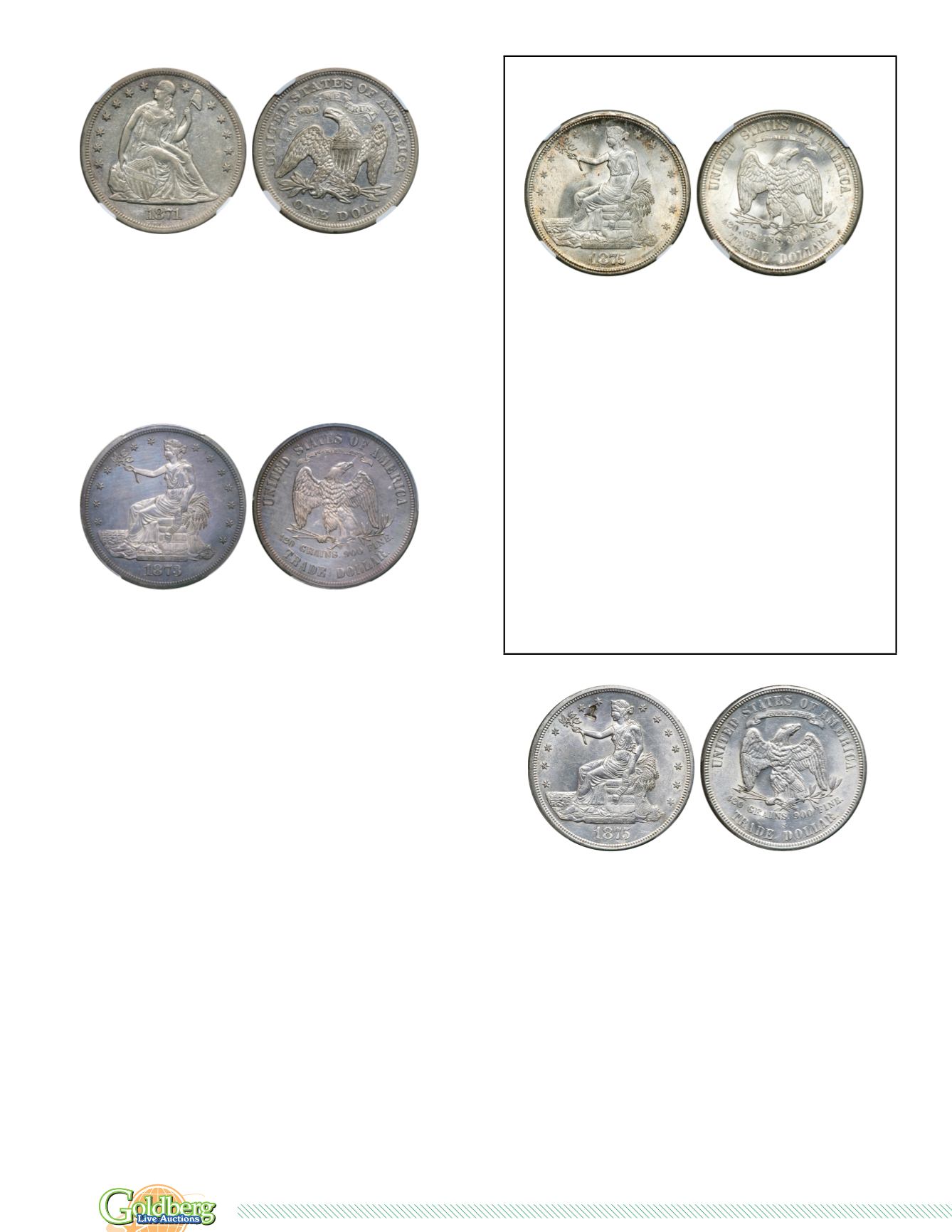
158
|
Dollars
937
1871
.
NGC graded EF-45
. Mostly untoned with luster visible.
Well struck example of the With Motto design, issued from 1866
to 1873.
Estimated Value ................................................... $500 - 550
938
1871
.
NGC graded EF-40
. Nice even toning.
Estimated Value ................................................... $450 - 500
Tr ade Do l l a r s
939
1873
.
PCGS graded Proof 62
. Nice even dusky gray toning
on both sides. Only 865 minted. Smooth fields with residual mir-
ror reflectivity and light horizontal hairlines on the surface but
most requiring magnification to see. Regarding this first year of
issue date, the clearest details are found throughout the periph-
eral areas but also encompassing the key central features of
Liberty and eagle, which are bold.
In an attempt to obtain the best possible design for the new
Trade Dollar, Mint Director Linderman used a provision of the
new Coinage Act of 1873 to hire outside artists. There were
several patterns made for the 1873 trade dollar, but in the end
Linderman chose one by Chief Engraver William Barber. The
adopted design had the familiar figure of a seated Liberty, but in
a somewhat different pose from the regular coinage. There was
a great deal of ceremony connected with the first trade dollar
coinage, and circulation-coin mintage was heavy for quite some
time.
Pop 49; 86 finer
. (
PCGS # 7053
)
Estimated Value ..............................................$1,900 - 2,000
Ex: Teich Family Collection
.
G
EM
U
NC
1875-S T
RADE
D
OLLAR
940
1875-S
.
NGC graded MS-66
. A nice frosty white coin. To
see this coin is to fall in love with it! Even if you collect
areas outside of Trade Dollars, spend a few minutes with it
at auction lot viewing, and see what we mean.
This specimen is downright brilliant, with delicate satin sur-
faces, a minimum of bagmarks, and a maximum of Mint
pizzazz in the luster. With an overall quality seldom seen,
you might shake your head once or twice in disbelief. To be
sure, there are some things here and there, including an
area of the obverse where die roller lines and somewhat
light striking occurs at Liberty’s head. But from a standpoint
of aesthetic beauty, such can be overlooked in the scheme
of things.
Two different hubs were utilized for both the obverse and
reverse during production of the trade dollar. Issues of
1875 and 1876 are the transitional coins of this series. All
1875 trade dollars were struck from the Type I obverse hub
with both reverse types in use. Among 1876 trade dollars,
both obverse and reverse hub types were used.
Pop 5;
none finer at NGC
.
Estimated Value .................................... $12,000 - 13,000
941
1875-S Chop Mark On The Obverse
.
PCGS graded MS-
61
. Untoned.
Pop 19; 63 finer, 39 in 62, 20 in 63, 4 in 64
for the "Chop Mark" designation. (
PCGS # 7039
)
The Trade Dollar was introduced to compete with the Mexican 8
reales and similar silver coinage in Europe and Asia. During the
early production years, many were sent overseas where they
found wide use in China. The local merchants would often note
their acceptance of the coins with their unique stamp or signa-
ture. These merchant stamps of approval would be hammered
into the coin with a punch mark, or chop, and have since
become known as chop marks. Some individual coins show only
one or two such marks; other, up to dozens of these chop
marks, reflecting their days in commerce on the Asian conti-
nent.
Estimated Value ................................................... $400 - 450
942
1876 PCGS graded Genuine Unc Details
. Cleaning. (
PCGS
# 7041
)
Estimated Value ................................................... $200 - 225


